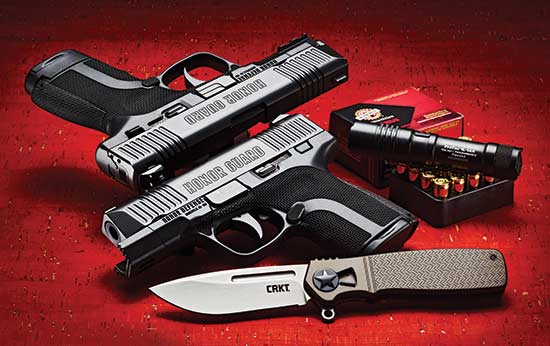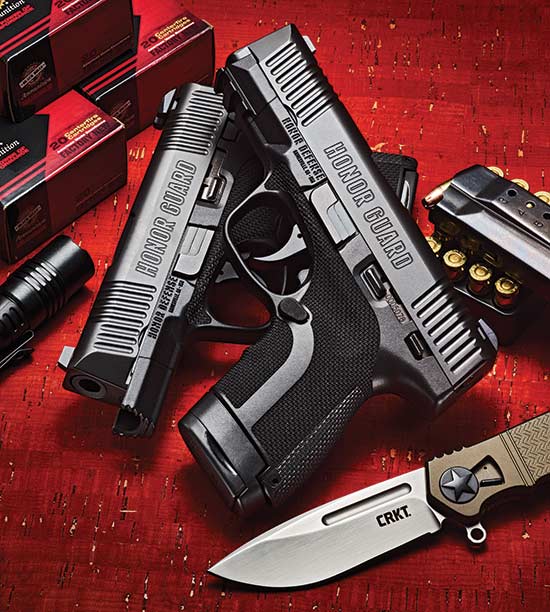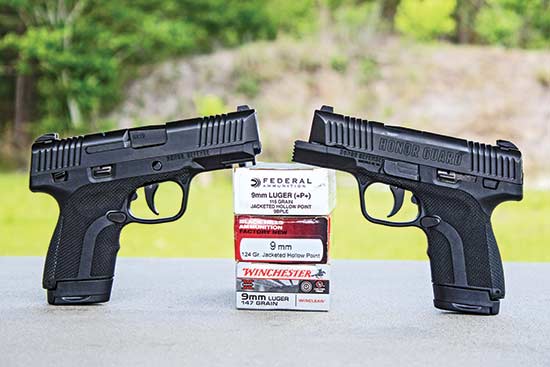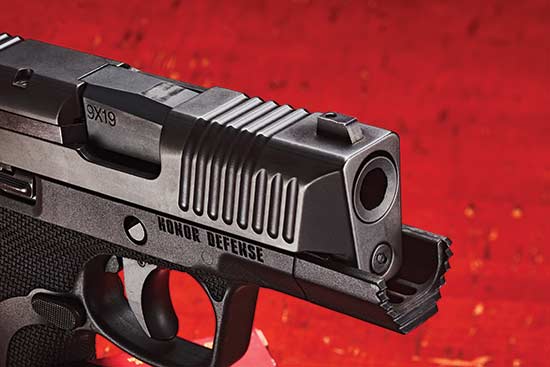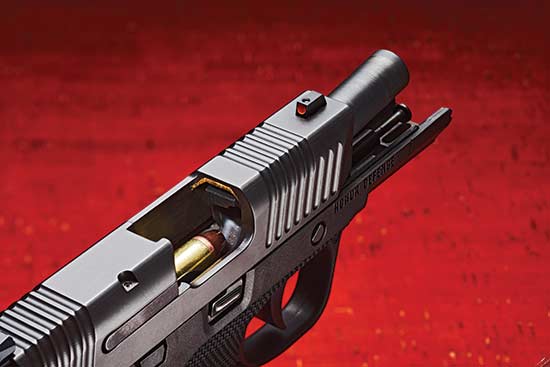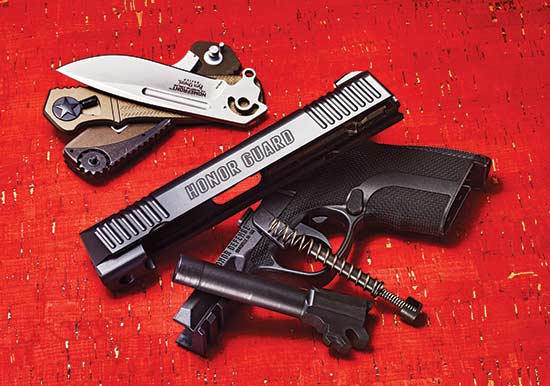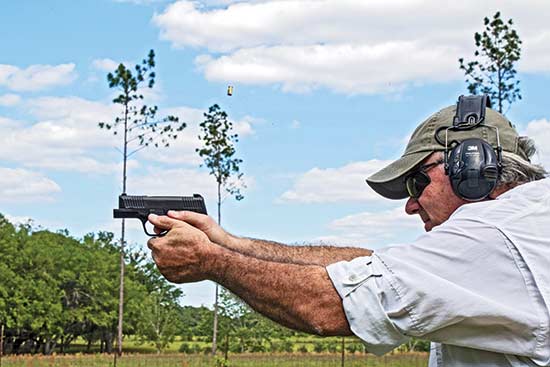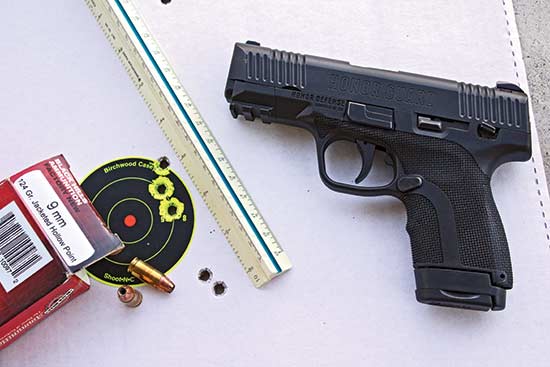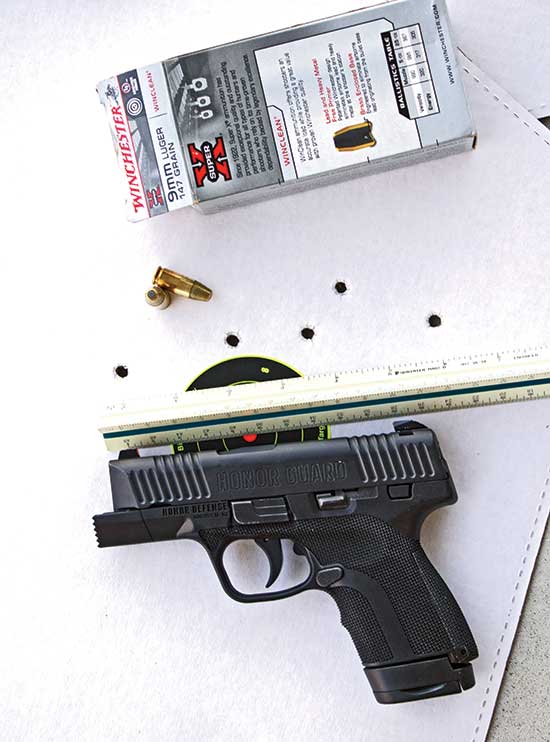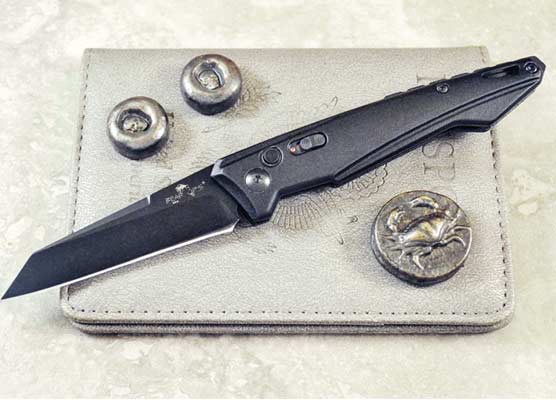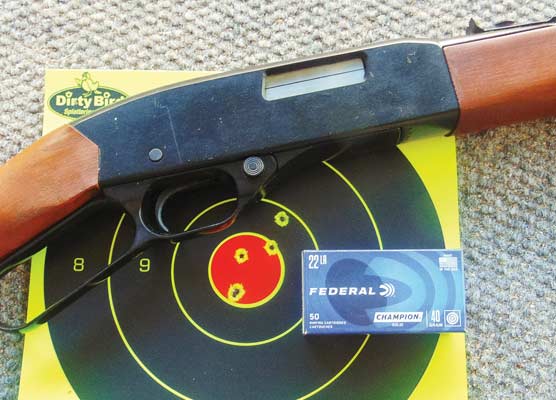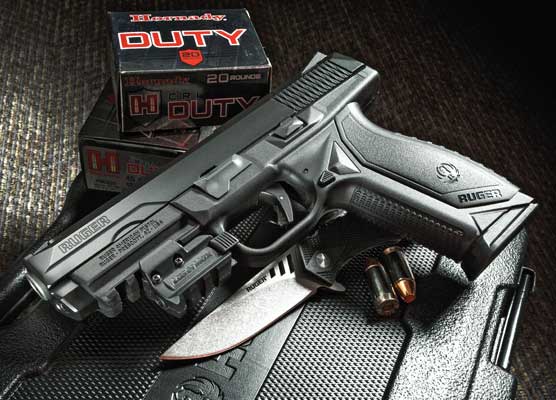On Guard Always!
Honor Defense Combined Some Old Ideas
To Come Up With A New Take On The
Striker-Fired 9mm Polymer Concept
Our editorial director Roy Huntington first called my attention to the Honor Guard pistol at SHOT Show and introduced me to the guy responsible for it, Gary Ramey of Honor Defense. Let’s take a look at how this innovative 9mm came about.
Gary had seen the rising popularity of “slim-nines,” full-power pistols which were slim amidships and compact. He thought he could make a better one. The overall shape of the resulting Honor Guard (though not its internals) resembles the super-popular S&W Shield. The Honor Guard is less than an inch wide. It is striker-fired with a polymer frame—the “in” configuration today, it seems—and comes with a short single-stack magazine holding 7 rounds for reduced butt profile and maximum concealment, and a longer 8 rounder with an extended buttplate.
Deep grasping grooves go up and over the top of the slide, front and rear, the better to manipulate it with wet or shaky hands in worst-case scenarios. The grip-frame comes from the factory with the kind of stippling many of us have paid custom gunsmiths to put on our polymer-framed pistols. The standard model comes with a short rail, allowing a small white light attachment if so desired. And then there is the FIST variation.
Stand-Off
Gary was smart enough to bring in consultants from the gun world as he crafted his design. They included Julianna Crowder, prime mover in the “Girl And A Gun” program, Nick Fleischman, an armorer with both military and LE credentials, and Britt Stabinski, US Navy, retired. It was Stabinski who pointed out the one shortcoming of most defensive autos is at press-contact—when your muzzle is at full contact with a deadly opponent—most barrel/slide assemblies will be pushed backward out of battery and thus can’t be fired. The FIST acronym stands for “Firearm with Integrated Standoff.” If this sounds a bit tortured, the concept makes up for it in tactical logic. On the FIST model, the Honor Guard’s muzzle sits well back from the projecting front edge of the frame’s dust cover. This prevents the gun from going out of battery in a hard press-contact shot. backward out of battery and thus can’t be fired. The FIST acronym stands for “Firearm with Integrated Standoff.” If this sounds a bit tortured, the concept makes up for it in tactical logic. On the FIST model, the Honor Guard’s muzzle sits well back from the projecting front edge of the frame’s dust cover. This prevents the gun from going out of battery in a hard press-contact shot.
Perhaps because today’s handgun combatives training combines hand-to-hand combat with shooting—some instructors are teaching a forward jab with the gun muzzle to deliver non-ballistic impact to the opponent—the front edge of the protuberant dust cover has sharp little teeth on it. It shows you some out-of-the-box thinking has gone into the design.
Nuts & Bolts
Some pistol packers appreciate a manual safety, if only for its handgun-retention factor if an opponent momentarily gains control of the weapon. Others demand simple “point and shoot” capability and see a thumb-safety as a bug, not a feature. Realizing this, Honor Defense offers the Honor Guard both ways—with or without a manual safety. If you choose “with,” it’s mounted on the frame with the Browning-style “up/safe, down/fire” mode. I didn’t find it hard to operate. We tried both. Our shooting samples had the ambidextrous, low-profile manual safety on the standard version, and no manual safety at all on the FIST version. You can order the Honor Guard either way.
The standard model is currently listed on the company website as the Long Slide variation and has a 3.8-inch barrel. The shorter top end of the FIST version encompasses a 3.2-inch barrel. Incidentally, Honor Defense also has the 3.2-inch barrel variation without the FIST feature, which they call the Subcompact model. Internally, the Honor Guard uses the “chassis” concept found on the SIG P320 and P250 and the Steyr M9.
On both my test guns, the trigger had a light take-up before it hit “the wall” of firm resistance and then rolled about 1/5 inch to let-off—like a very short double-action revolver pull. There was little backlash or rearward movement of the trigger after the break, and no backlash at all was perceptible in live fire as opposed to slow dry fire.
On the Lyman digital gauge, I measured the pulls of each specimen twice—once from the toe or bottom tip of the trigger, and again from the center. With the pivoting trigger of the Honor Guard, basic leverage comes into play—shooters often measure from the toe, which gives more leverage and requires less effort, but most shooters apply pressure on the center of the trigger, hence the second measurement.
The standard model averaged 6.58 pounds at the toe and 8.54 pounds at the center. The FIST model went 6.56 pounds at the toe and 7.92 at the center. By way of comparison, the first Honor Guard I tested for American Handgunner earlier went 7.96 pounds at the toe and 9.07 from the center. Between the pistols sent to GUNS for this test, the FIST’s trigger was a bit smoother than the Long Slide’s, but both were certainly controllable.
With the opportunity to test two samples together, I figured, why not compare three? I like to use three different brands and bullet weights for the caliber, and looked up my earlier American Handgunner test for my first FIST. I used the same loads for the two pistols I benched for GUNS.
The fresh-from-the box FIST version punched five 9mm 115-grain Federal +P+ JHP’s into 5.90 inches (best 3 in 2.10). It hammered 5 Black Hills 124-grain JHP’s into 4.05 (best 3 into 2.05). Finally, with Winchester 147-grain subsonic training ammo with a jacketed truncated cone bullet, the FIST smacked five into 5.95 inches (best 3 in 2.25).
This was pretty much in lockstep with what the same loads had given me a year earlier in the AH FIST test. With the Federal +P+, my earlier gun had given 7.60 inches (3.0 for best three). The Black Hills had delivered 7.50 inches (best 3 in 1.75) and the Winchester Subsonic, 7.75 inches (3.0 for best three).
The standard model with light rail instead of stand-off configuration turned out to be much more accurate. The hot Federal +P+ (which, by the way, Honor Guard’s warranty won’t cover, though the pistols are rated for +P), put all 5 shots into 2.20 inches (best three in a sweet 0.65 cluster). The 124-grain Black Hills JHP yielded a 3.15-inch 5-shot group, with the best 3 in 1.1 inches. The 147-grain Winchester’s 5-shot group stretched to 4.55 inches, but the best 3 were in an inch even.
No new gun escapes teething pains. There’s always something that doesn’t become apparent until it’s out there in shooters’ hands in the real world. Gary Ramey knew many new gun manufacturers went out of business because they were under-capitalized (setting up the machinery to make guns is a huge expense). Being business-savvy, he outsourced as many of the parts as possible, and made Honor Guard an assembly point.
Early on, a shipment of barrels didn’t make spec, and he had to send them back to the manufacturer and go to another source. This could explain why the two FIST pistols I tested didn’t come close to the standard model for accuracy. The FIST I tested initially for American Handgunner was a very early serial number, and so was the FIST they sent to GUNS. I expect it was set aside early on as a test pistol for gun writers. However, the new standard model giving much better accuracy had a much later serial number after Gary had found the right sub-contractor to do the barrels. This tells me the ones available now are the more accurate ones.
With three of these guns now, and lots of friends who like to shoot new guns, the “test team” and I are way into a four-figure round count through Honor Guards. We’ve shot them deliberately limp-wristed, and even upside down. Testers have varied from 5-foot females to 6-foot-plus Creatures From the Testosterone Lagoon. Ammo has varied from USPSA handloads to standard pressure to +P and +P+. There has been exactly one malfunction—a slide that locked open while shooting from a bench rest, almost certainly because the shooter’s thumb hit the slide stop during recoil. Thumbing down the slide stop instantly rectified the problem. I think this counts for 100 percent mechanical function (in my book, if your fingers get in the way of the moving parts of the machine, it ain’t the machine’s fault).
Reliability is, of course, the non-negotiable baseline in defensive firearm selection, and it looks to me as if the Honor Guard passes.
The Bottom Line
There is a lot to like about the Honor Guard pistols. I like the sights—a big orange ball up front, white dots in the rear, and a generous sight picture. I like the feel of the gun. I like the soft recoil. I appreciate the tactical thought in the FIST option, which is going to be worth either nothing or the whole rest of your life, depending how your particular fight for survival goes. I like the option of the ambidextrous thumb safety. Being an old man with arthritis-twisted fingers, I particularly like the ambidextrous mag release—which in addition to being southpaw friendly—allows us right-handed shooters to dump a spent mag with the trigger finger.
As an American, I also like CEO Gary Ramey’s policy of hiring veterans to work at Honor Guard.
My primary beef with the gun was the mediocre accuracy of two of the three samples, but judging by the late production standard model we tested here, it looks as if the company has squared away the problem in current production. I also have to say the itty-bitty slide stop is hard to hit, and having found using the slide stop instead of a slide tug to complete a reload will save about 8/10 of a valuable second, I wish the slide stop/slide release lever was bigger and more accessible.
Starting at $499, this pistol is in the ballpark for high-quality “slim-nines” and I for one consider it a very good value.
Honor Guard
Maker: Honor Defense
2295 Skelton Rd.
D-1, Gainsville, GA 30501
(678) 943-8035
honordefense.com
Type: Striker-fired semi-auto
Caliber: 9mm (+P rated)
Capacity: 7+1, 8+1
Barrel length: 3.2-3.8 inches
Overall length: 6.2-6.8 inches
Weight: 22-25 ounces
Sights: Fixed 3-dot combat-type
Finish: Matte black stainless
Grips: Polymer (small and large backstraps included)
Price: Starts at $499
